Contact Tracing .
VerifiedAdded on 2023/05/29
|13
|3010
|188
AI Summary
This report discusses contact tracing in epidemiology and its application to Tuberculosis in Australia. It covers the disease burden of Tuberculosis in Australia, mode of transmission, high-risk groups for contact tracing, and steps taken for identified contacts. It also discusses the time the index case will return to class and the safety of the community.
Contribute Materials
Your contribution can guide someone’s learning journey. Share your
documents today.
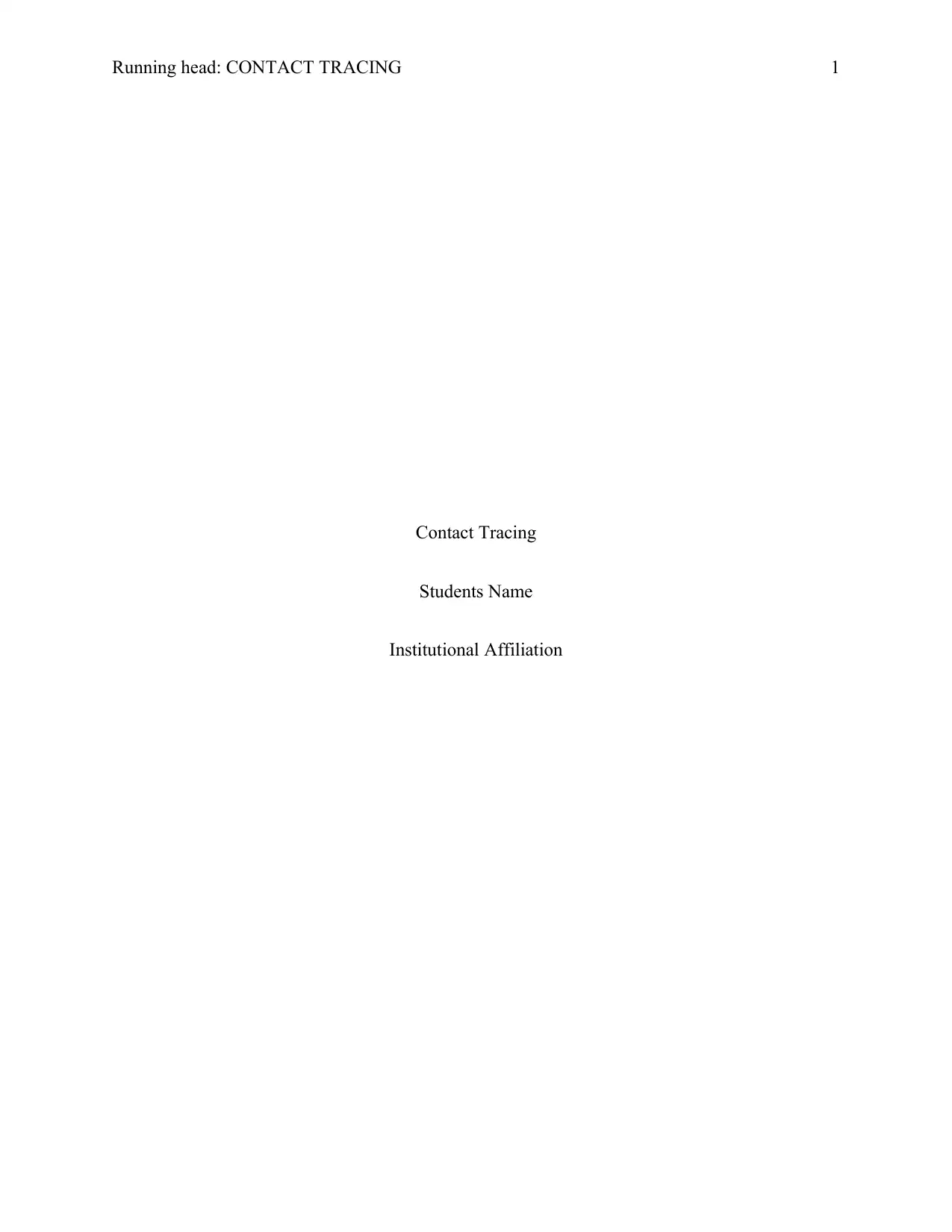
Running head: CONTACT TRACING 1
Contact Tracing
Students Name
Institutional Affiliation
Contact Tracing
Students Name
Institutional Affiliation
Secure Best Marks with AI Grader
Need help grading? Try our AI Grader for instant feedback on your assignments.
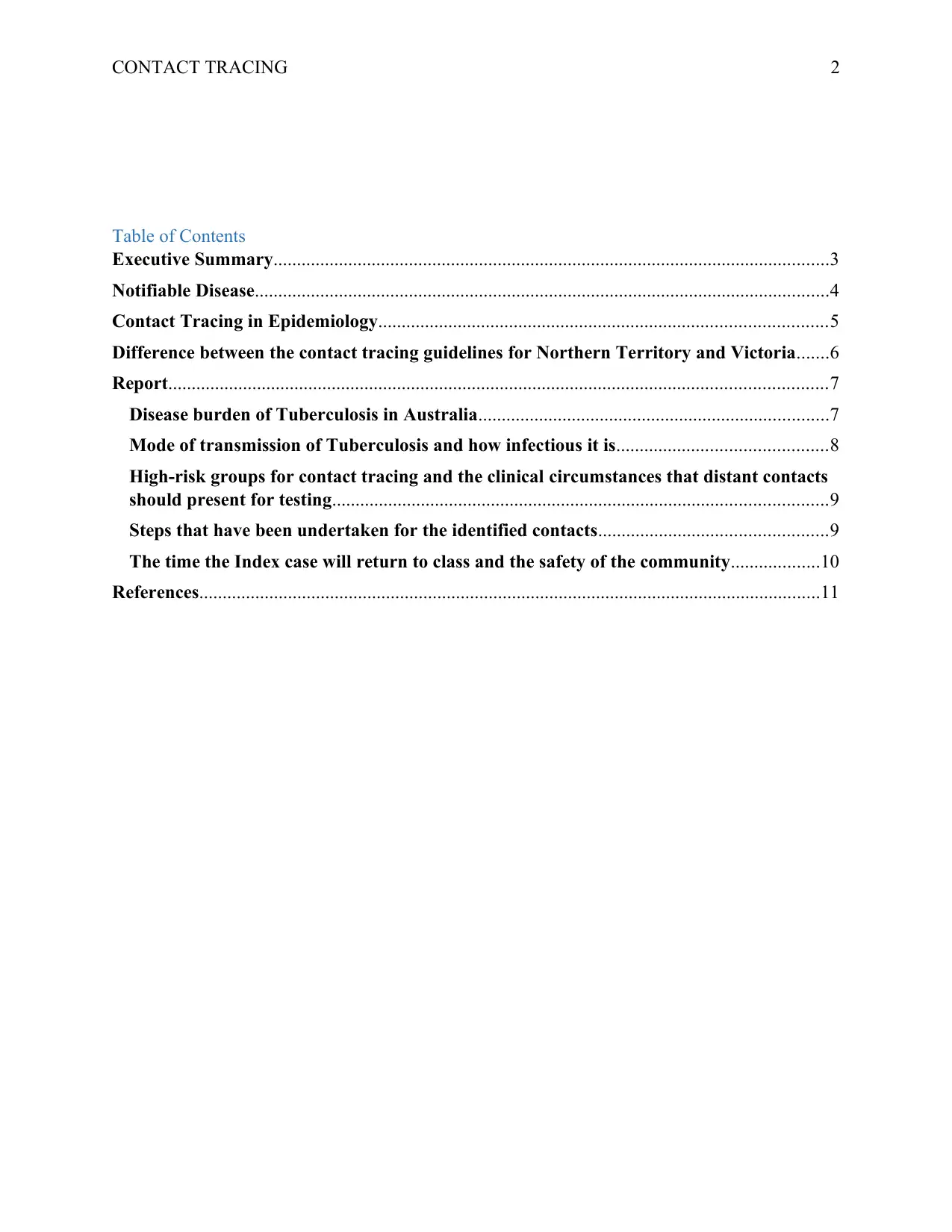
CONTACT TRACING 2
Table of Contents
Executive Summary.......................................................................................................................3
Notifiable Disease...........................................................................................................................4
Contact Tracing in Epidemiology................................................................................................5
Difference between the contact tracing guidelines for Northern Territory and Victoria.......6
Report.............................................................................................................................................7
Disease burden of Tuberculosis in Australia...........................................................................7
Mode of transmission of Tuberculosis and how infectious it is.............................................8
High-risk groups for contact tracing and the clinical circumstances that distant contacts
should present for testing..........................................................................................................9
Steps that have been undertaken for the identified contacts.................................................9
The time the Index case will return to class and the safety of the community...................10
References.....................................................................................................................................11
Table of Contents
Executive Summary.......................................................................................................................3
Notifiable Disease...........................................................................................................................4
Contact Tracing in Epidemiology................................................................................................5
Difference between the contact tracing guidelines for Northern Territory and Victoria.......6
Report.............................................................................................................................................7
Disease burden of Tuberculosis in Australia...........................................................................7
Mode of transmission of Tuberculosis and how infectious it is.............................................8
High-risk groups for contact tracing and the clinical circumstances that distant contacts
should present for testing..........................................................................................................9
Steps that have been undertaken for the identified contacts.................................................9
The time the Index case will return to class and the safety of the community...................10
References.....................................................................................................................................11
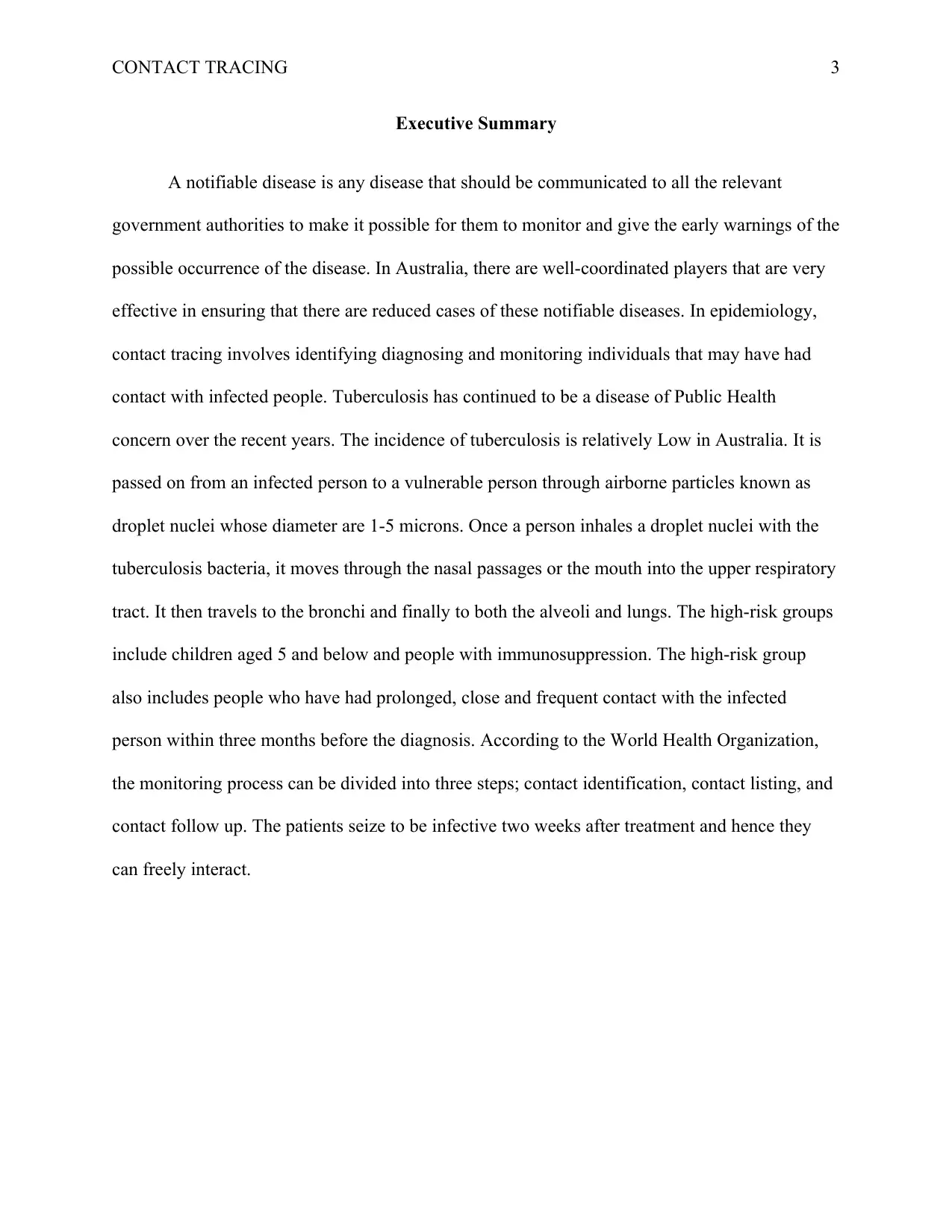
CONTACT TRACING 3
Executive Summary
A notifiable disease is any disease that should be communicated to all the relevant
government authorities to make it possible for them to monitor and give the early warnings of the
possible occurrence of the disease. In Australia, there are well-coordinated players that are very
effective in ensuring that there are reduced cases of these notifiable diseases. In epidemiology,
contact tracing involves identifying diagnosing and monitoring individuals that may have had
contact with infected people. Tuberculosis has continued to be a disease of Public Health
concern over the recent years. The incidence of tuberculosis is relatively Low in Australia. It is
passed on from an infected person to a vulnerable person through airborne particles known as
droplet nuclei whose diameter are 1-5 microns. Once a person inhales a droplet nuclei with the
tuberculosis bacteria, it moves through the nasal passages or the mouth into the upper respiratory
tract. It then travels to the bronchi and finally to both the alveoli and lungs. The high-risk groups
include children aged 5 and below and people with immunosuppression. The high-risk group
also includes people who have had prolonged, close and frequent contact with the infected
person within three months before the diagnosis. According to the World Health Organization,
the monitoring process can be divided into three steps; contact identification, contact listing, and
contact follow up. The patients seize to be infective two weeks after treatment and hence they
can freely interact.
Executive Summary
A notifiable disease is any disease that should be communicated to all the relevant
government authorities to make it possible for them to monitor and give the early warnings of the
possible occurrence of the disease. In Australia, there are well-coordinated players that are very
effective in ensuring that there are reduced cases of these notifiable diseases. In epidemiology,
contact tracing involves identifying diagnosing and monitoring individuals that may have had
contact with infected people. Tuberculosis has continued to be a disease of Public Health
concern over the recent years. The incidence of tuberculosis is relatively Low in Australia. It is
passed on from an infected person to a vulnerable person through airborne particles known as
droplet nuclei whose diameter are 1-5 microns. Once a person inhales a droplet nuclei with the
tuberculosis bacteria, it moves through the nasal passages or the mouth into the upper respiratory
tract. It then travels to the bronchi and finally to both the alveoli and lungs. The high-risk groups
include children aged 5 and below and people with immunosuppression. The high-risk group
also includes people who have had prolonged, close and frequent contact with the infected
person within three months before the diagnosis. According to the World Health Organization,
the monitoring process can be divided into three steps; contact identification, contact listing, and
contact follow up. The patients seize to be infective two weeks after treatment and hence they
can freely interact.
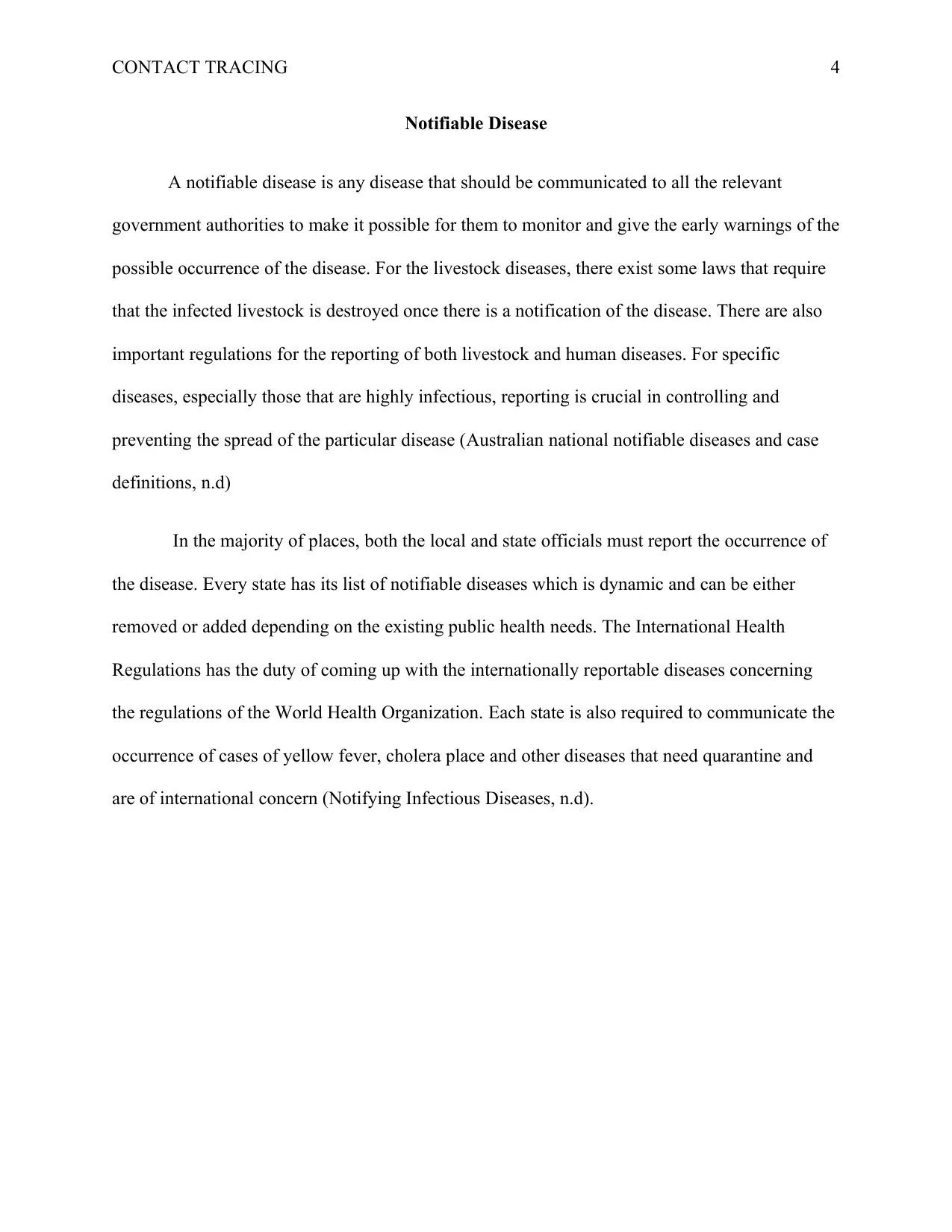
CONTACT TRACING 4
Notifiable Disease
A notifiable disease is any disease that should be communicated to all the relevant
government authorities to make it possible for them to monitor and give the early warnings of the
possible occurrence of the disease. For the livestock diseases, there exist some laws that require
that the infected livestock is destroyed once there is a notification of the disease. There are also
important regulations for the reporting of both livestock and human diseases. For specific
diseases, especially those that are highly infectious, reporting is crucial in controlling and
preventing the spread of the particular disease (Australian national notifiable diseases and case
definitions, n.d)
In the majority of places, both the local and state officials must report the occurrence of
the disease. Every state has its list of notifiable diseases which is dynamic and can be either
removed or added depending on the existing public health needs. The International Health
Regulations has the duty of coming up with the internationally reportable diseases concerning
the regulations of the World Health Organization. Each state is also required to communicate the
occurrence of cases of yellow fever, cholera place and other diseases that need quarantine and
are of international concern (Notifying Infectious Diseases, n.d).
Notifiable Disease
A notifiable disease is any disease that should be communicated to all the relevant
government authorities to make it possible for them to monitor and give the early warnings of the
possible occurrence of the disease. For the livestock diseases, there exist some laws that require
that the infected livestock is destroyed once there is a notification of the disease. There are also
important regulations for the reporting of both livestock and human diseases. For specific
diseases, especially those that are highly infectious, reporting is crucial in controlling and
preventing the spread of the particular disease (Australian national notifiable diseases and case
definitions, n.d)
In the majority of places, both the local and state officials must report the occurrence of
the disease. Every state has its list of notifiable diseases which is dynamic and can be either
removed or added depending on the existing public health needs. The International Health
Regulations has the duty of coming up with the internationally reportable diseases concerning
the regulations of the World Health Organization. Each state is also required to communicate the
occurrence of cases of yellow fever, cholera place and other diseases that need quarantine and
are of international concern (Notifying Infectious Diseases, n.d).
Secure Best Marks with AI Grader
Need help grading? Try our AI Grader for instant feedback on your assignments.
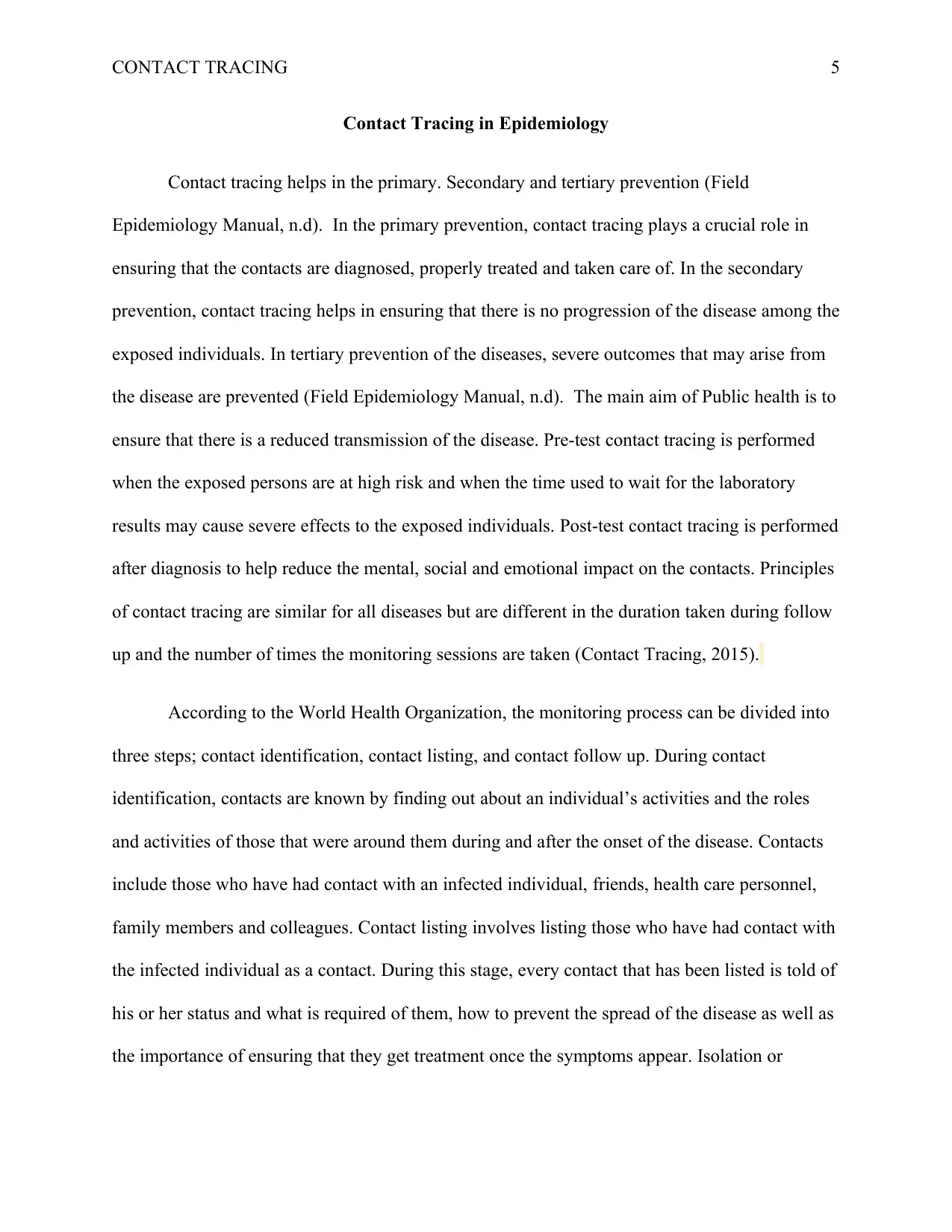
CONTACT TRACING 5
Contact Tracing in Epidemiology
Contact tracing helps in the primary. Secondary and tertiary prevention (Field
Epidemiology Manual, n.d). In the primary prevention, contact tracing plays a crucial role in
ensuring that the contacts are diagnosed, properly treated and taken care of. In the secondary
prevention, contact tracing helps in ensuring that there is no progression of the disease among the
exposed individuals. In tertiary prevention of the diseases, severe outcomes that may arise from
the disease are prevented (Field Epidemiology Manual, n.d). The main aim of Public health is to
ensure that there is a reduced transmission of the disease. Pre-test contact tracing is performed
when the exposed persons are at high risk and when the time used to wait for the laboratory
results may cause severe effects to the exposed individuals. Post-test contact tracing is performed
after diagnosis to help reduce the mental, social and emotional impact on the contacts. Principles
of contact tracing are similar for all diseases but are different in the duration taken during follow
up and the number of times the monitoring sessions are taken (Contact Tracing, 2015).
According to the World Health Organization, the monitoring process can be divided into
three steps; contact identification, contact listing, and contact follow up. During contact
identification, contacts are known by finding out about an individual’s activities and the roles
and activities of those that were around them during and after the onset of the disease. Contacts
include those who have had contact with an infected individual, friends, health care personnel,
family members and colleagues. Contact listing involves listing those who have had contact with
the infected individual as a contact. During this stage, every contact that has been listed is told of
his or her status and what is required of them, how to prevent the spread of the disease as well as
the importance of ensuring that they get treatment once the symptoms appear. Isolation or
Contact Tracing in Epidemiology
Contact tracing helps in the primary. Secondary and tertiary prevention (Field
Epidemiology Manual, n.d). In the primary prevention, contact tracing plays a crucial role in
ensuring that the contacts are diagnosed, properly treated and taken care of. In the secondary
prevention, contact tracing helps in ensuring that there is no progression of the disease among the
exposed individuals. In tertiary prevention of the diseases, severe outcomes that may arise from
the disease are prevented (Field Epidemiology Manual, n.d). The main aim of Public health is to
ensure that there is a reduced transmission of the disease. Pre-test contact tracing is performed
when the exposed persons are at high risk and when the time used to wait for the laboratory
results may cause severe effects to the exposed individuals. Post-test contact tracing is performed
after diagnosis to help reduce the mental, social and emotional impact on the contacts. Principles
of contact tracing are similar for all diseases but are different in the duration taken during follow
up and the number of times the monitoring sessions are taken (Contact Tracing, 2015).
According to the World Health Organization, the monitoring process can be divided into
three steps; contact identification, contact listing, and contact follow up. During contact
identification, contacts are known by finding out about an individual’s activities and the roles
and activities of those that were around them during and after the onset of the disease. Contacts
include those who have had contact with an infected individual, friends, health care personnel,
family members and colleagues. Contact listing involves listing those who have had contact with
the infected individual as a contact. During this stage, every contact that has been listed is told of
his or her status and what is required of them, how to prevent the spread of the disease as well as
the importance of ensuring that they get treatment once the symptoms appear. Isolation or
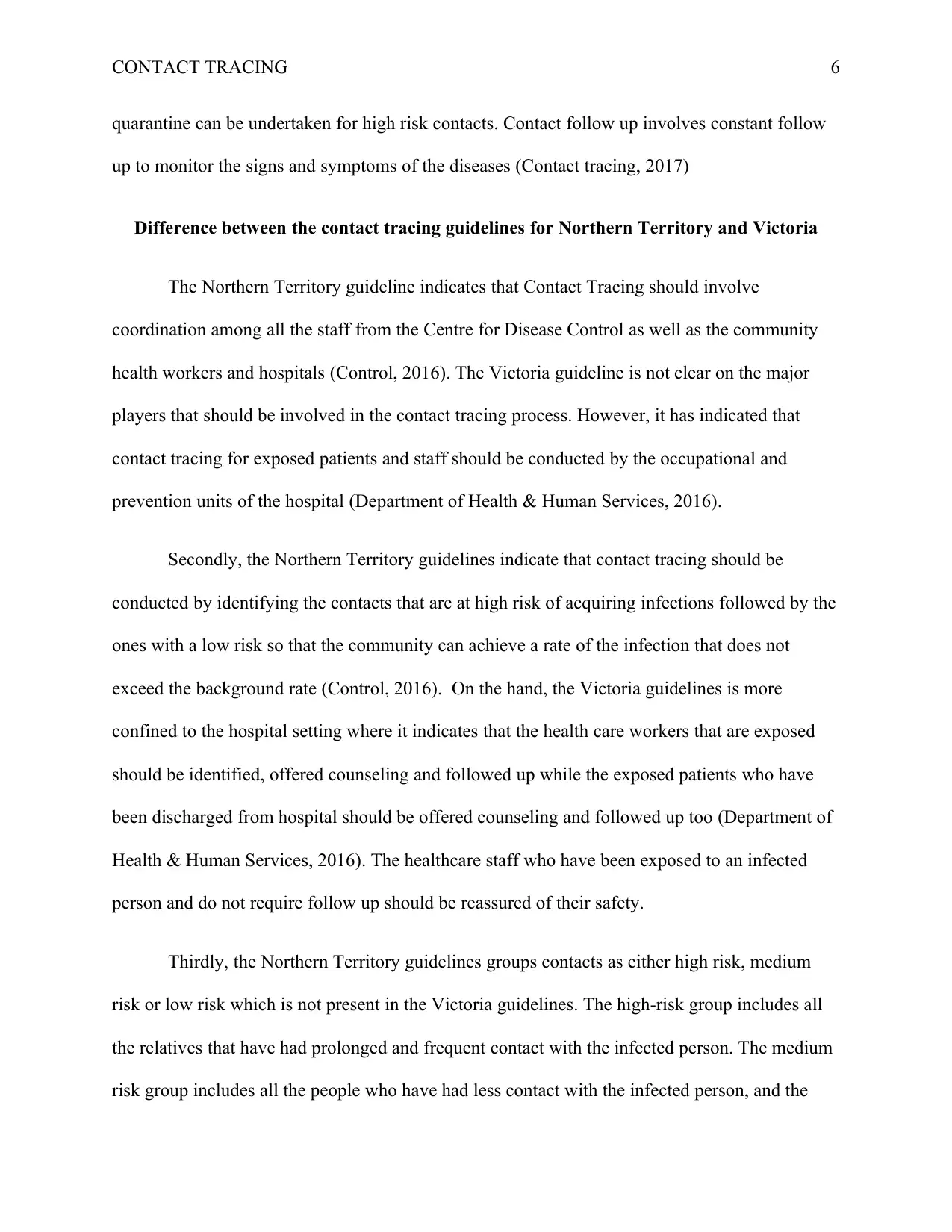
CONTACT TRACING 6
quarantine can be undertaken for high risk contacts. Contact follow up involves constant follow
up to monitor the signs and symptoms of the diseases (Contact tracing, 2017)
Difference between the contact tracing guidelines for Northern Territory and Victoria
The Northern Territory guideline indicates that Contact Tracing should involve
coordination among all the staff from the Centre for Disease Control as well as the community
health workers and hospitals (Control, 2016). The Victoria guideline is not clear on the major
players that should be involved in the contact tracing process. However, it has indicated that
contact tracing for exposed patients and staff should be conducted by the occupational and
prevention units of the hospital (Department of Health & Human Services, 2016).
Secondly, the Northern Territory guidelines indicate that contact tracing should be
conducted by identifying the contacts that are at high risk of acquiring infections followed by the
ones with a low risk so that the community can achieve a rate of the infection that does not
exceed the background rate (Control, 2016). On the hand, the Victoria guidelines is more
confined to the hospital setting where it indicates that the health care workers that are exposed
should be identified, offered counseling and followed up while the exposed patients who have
been discharged from hospital should be offered counseling and followed up too (Department of
Health & Human Services, 2016). The healthcare staff who have been exposed to an infected
person and do not require follow up should be reassured of their safety.
Thirdly, the Northern Territory guidelines groups contacts as either high risk, medium
risk or low risk which is not present in the Victoria guidelines. The high-risk group includes all
the relatives that have had prolonged and frequent contact with the infected person. The medium
risk group includes all the people who have had less contact with the infected person, and the
quarantine can be undertaken for high risk contacts. Contact follow up involves constant follow
up to monitor the signs and symptoms of the diseases (Contact tracing, 2017)
Difference between the contact tracing guidelines for Northern Territory and Victoria
The Northern Territory guideline indicates that Contact Tracing should involve
coordination among all the staff from the Centre for Disease Control as well as the community
health workers and hospitals (Control, 2016). The Victoria guideline is not clear on the major
players that should be involved in the contact tracing process. However, it has indicated that
contact tracing for exposed patients and staff should be conducted by the occupational and
prevention units of the hospital (Department of Health & Human Services, 2016).
Secondly, the Northern Territory guidelines indicate that contact tracing should be
conducted by identifying the contacts that are at high risk of acquiring infections followed by the
ones with a low risk so that the community can achieve a rate of the infection that does not
exceed the background rate (Control, 2016). On the hand, the Victoria guidelines is more
confined to the hospital setting where it indicates that the health care workers that are exposed
should be identified, offered counseling and followed up while the exposed patients who have
been discharged from hospital should be offered counseling and followed up too (Department of
Health & Human Services, 2016). The healthcare staff who have been exposed to an infected
person and do not require follow up should be reassured of their safety.
Thirdly, the Northern Territory guidelines groups contacts as either high risk, medium
risk or low risk which is not present in the Victoria guidelines. The high-risk group includes all
the relatives that have had prolonged and frequent contact with the infected person. The medium
risk group includes all the people who have had less contact with the infected person, and the
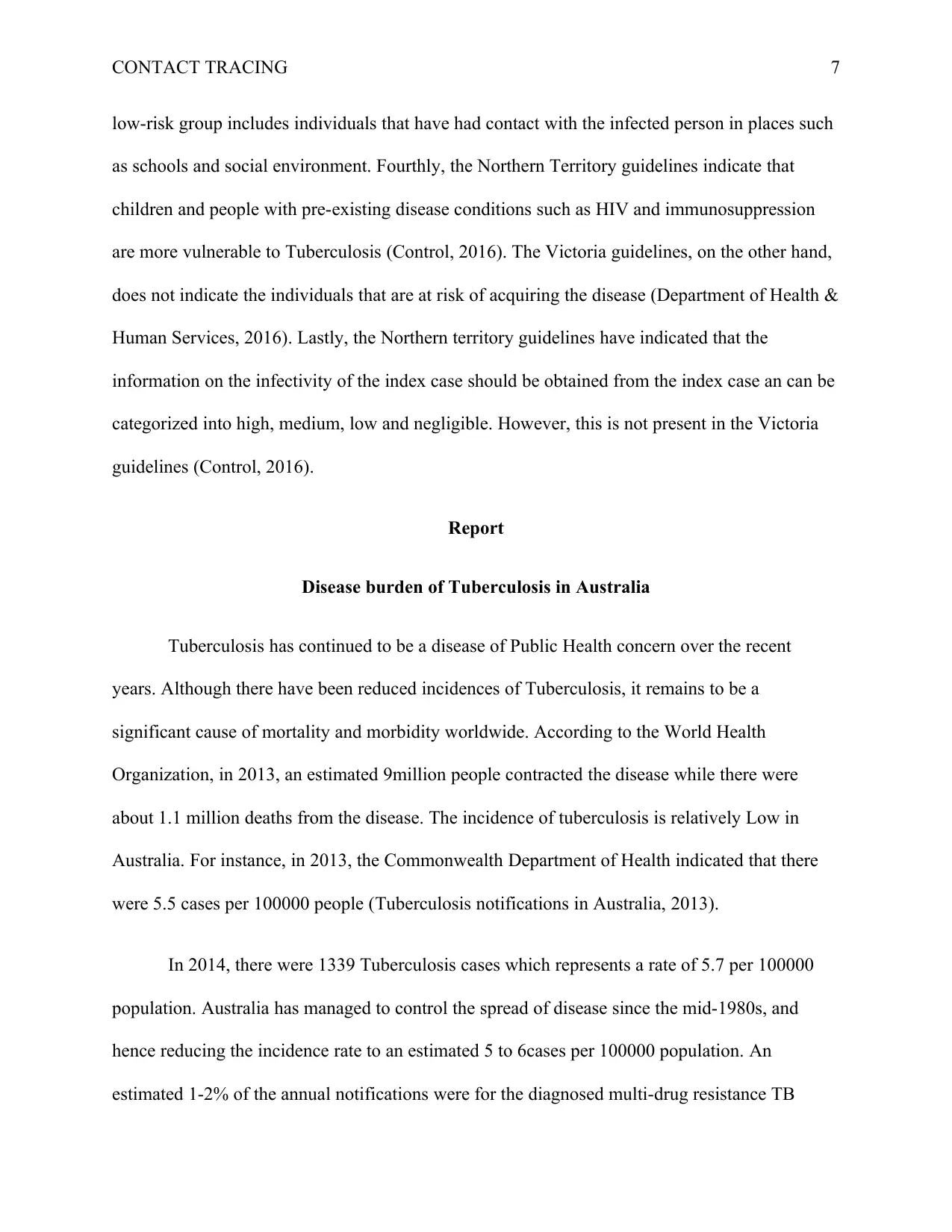
CONTACT TRACING 7
low-risk group includes individuals that have had contact with the infected person in places such
as schools and social environment. Fourthly, the Northern Territory guidelines indicate that
children and people with pre-existing disease conditions such as HIV and immunosuppression
are more vulnerable to Tuberculosis (Control, 2016). The Victoria guidelines, on the other hand,
does not indicate the individuals that are at risk of acquiring the disease (Department of Health &
Human Services, 2016). Lastly, the Northern territory guidelines have indicated that the
information on the infectivity of the index case should be obtained from the index case an can be
categorized into high, medium, low and negligible. However, this is not present in the Victoria
guidelines (Control, 2016).
Report
Disease burden of Tuberculosis in Australia
Tuberculosis has continued to be a disease of Public Health concern over the recent
years. Although there have been reduced incidences of Tuberculosis, it remains to be a
significant cause of mortality and morbidity worldwide. According to the World Health
Organization, in 2013, an estimated 9million people contracted the disease while there were
about 1.1 million deaths from the disease. The incidence of tuberculosis is relatively Low in
Australia. For instance, in 2013, the Commonwealth Department of Health indicated that there
were 5.5 cases per 100000 people (Tuberculosis notifications in Australia, 2013).
In 2014, there were 1339 Tuberculosis cases which represents a rate of 5.7 per 100000
population. Australia has managed to control the spread of disease since the mid-1980s, and
hence reducing the incidence rate to an estimated 5 to 6cases per 100000 population. An
estimated 1-2% of the annual notifications were for the diagnosed multi-drug resistance TB
low-risk group includes individuals that have had contact with the infected person in places such
as schools and social environment. Fourthly, the Northern Territory guidelines indicate that
children and people with pre-existing disease conditions such as HIV and immunosuppression
are more vulnerable to Tuberculosis (Control, 2016). The Victoria guidelines, on the other hand,
does not indicate the individuals that are at risk of acquiring the disease (Department of Health &
Human Services, 2016). Lastly, the Northern territory guidelines have indicated that the
information on the infectivity of the index case should be obtained from the index case an can be
categorized into high, medium, low and negligible. However, this is not present in the Victoria
guidelines (Control, 2016).
Report
Disease burden of Tuberculosis in Australia
Tuberculosis has continued to be a disease of Public Health concern over the recent
years. Although there have been reduced incidences of Tuberculosis, it remains to be a
significant cause of mortality and morbidity worldwide. According to the World Health
Organization, in 2013, an estimated 9million people contracted the disease while there were
about 1.1 million deaths from the disease. The incidence of tuberculosis is relatively Low in
Australia. For instance, in 2013, the Commonwealth Department of Health indicated that there
were 5.5 cases per 100000 people (Tuberculosis notifications in Australia, 2013).
In 2014, there were 1339 Tuberculosis cases which represents a rate of 5.7 per 100000
population. Australia has managed to control the spread of disease since the mid-1980s, and
hence reducing the incidence rate to an estimated 5 to 6cases per 100000 population. An
estimated 1-2% of the annual notifications were for the diagnosed multi-drug resistance TB
Paraphrase This Document
Need a fresh take? Get an instant paraphrase of this document with our AI Paraphraser
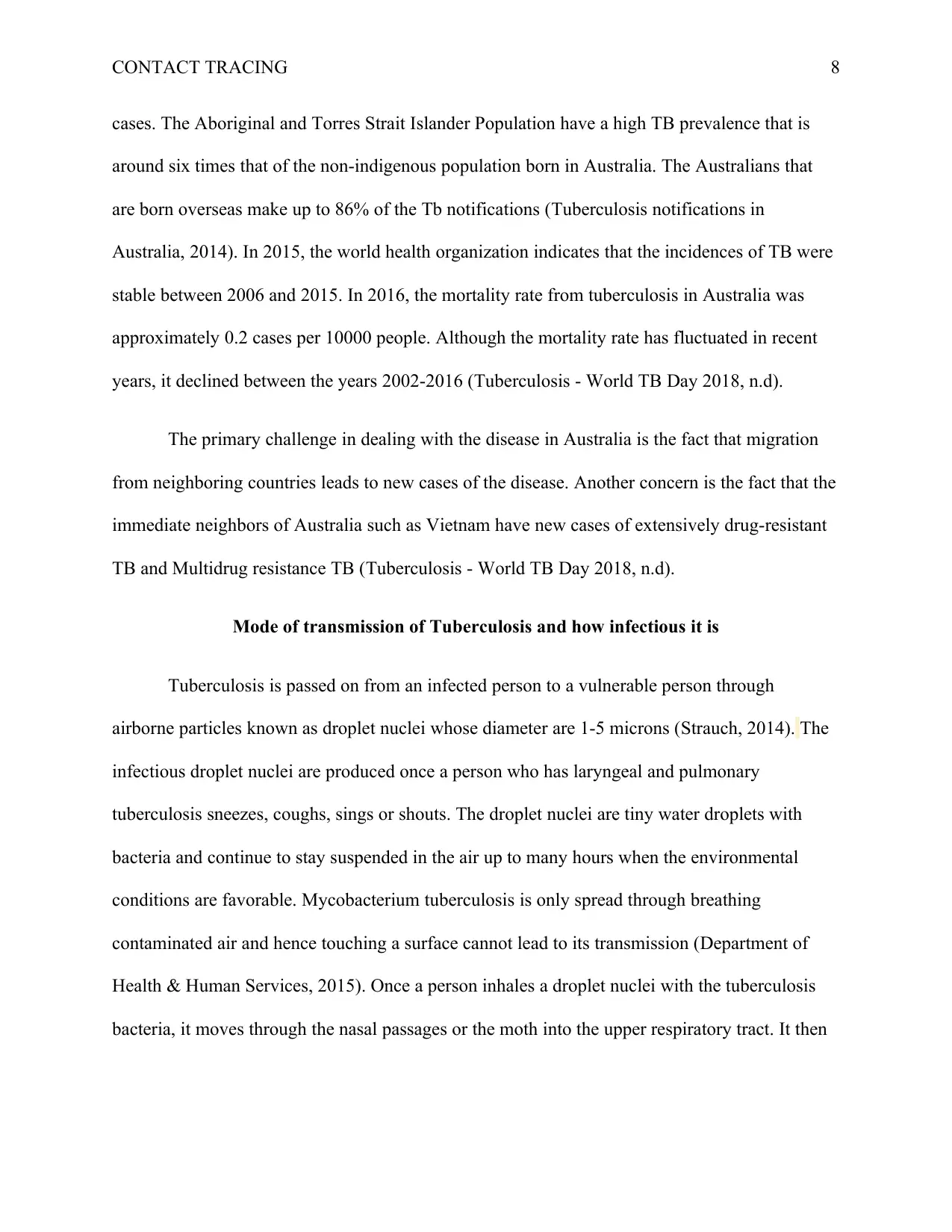
CONTACT TRACING 8
cases. The Aboriginal and Torres Strait Islander Population have a high TB prevalence that is
around six times that of the non-indigenous population born in Australia. The Australians that
are born overseas make up to 86% of the Tb notifications (Tuberculosis notifications in
Australia, 2014). In 2015, the world health organization indicates that the incidences of TB were
stable between 2006 and 2015. In 2016, the mortality rate from tuberculosis in Australia was
approximately 0.2 cases per 10000 people. Although the mortality rate has fluctuated in recent
years, it declined between the years 2002-2016 (Tuberculosis - World TB Day 2018, n.d).
The primary challenge in dealing with the disease in Australia is the fact that migration
from neighboring countries leads to new cases of the disease. Another concern is the fact that the
immediate neighbors of Australia such as Vietnam have new cases of extensively drug-resistant
TB and Multidrug resistance TB (Tuberculosis - World TB Day 2018, n.d).
Mode of transmission of Tuberculosis and how infectious it is
Tuberculosis is passed on from an infected person to a vulnerable person through
airborne particles known as droplet nuclei whose diameter are 1-5 microns (Strauch, 2014). The
infectious droplet nuclei are produced once a person who has laryngeal and pulmonary
tuberculosis sneezes, coughs, sings or shouts. The droplet nuclei are tiny water droplets with
bacteria and continue to stay suspended in the air up to many hours when the environmental
conditions are favorable. Mycobacterium tuberculosis is only spread through breathing
contaminated air and hence touching a surface cannot lead to its transmission (Department of
Health & Human Services, 2015). Once a person inhales a droplet nuclei with the tuberculosis
bacteria, it moves through the nasal passages or the moth into the upper respiratory tract. It then
cases. The Aboriginal and Torres Strait Islander Population have a high TB prevalence that is
around six times that of the non-indigenous population born in Australia. The Australians that
are born overseas make up to 86% of the Tb notifications (Tuberculosis notifications in
Australia, 2014). In 2015, the world health organization indicates that the incidences of TB were
stable between 2006 and 2015. In 2016, the mortality rate from tuberculosis in Australia was
approximately 0.2 cases per 10000 people. Although the mortality rate has fluctuated in recent
years, it declined between the years 2002-2016 (Tuberculosis - World TB Day 2018, n.d).
The primary challenge in dealing with the disease in Australia is the fact that migration
from neighboring countries leads to new cases of the disease. Another concern is the fact that the
immediate neighbors of Australia such as Vietnam have new cases of extensively drug-resistant
TB and Multidrug resistance TB (Tuberculosis - World TB Day 2018, n.d).
Mode of transmission of Tuberculosis and how infectious it is
Tuberculosis is passed on from an infected person to a vulnerable person through
airborne particles known as droplet nuclei whose diameter are 1-5 microns (Strauch, 2014). The
infectious droplet nuclei are produced once a person who has laryngeal and pulmonary
tuberculosis sneezes, coughs, sings or shouts. The droplet nuclei are tiny water droplets with
bacteria and continue to stay suspended in the air up to many hours when the environmental
conditions are favorable. Mycobacterium tuberculosis is only spread through breathing
contaminated air and hence touching a surface cannot lead to its transmission (Department of
Health & Human Services, 2015). Once a person inhales a droplet nuclei with the tuberculosis
bacteria, it moves through the nasal passages or the moth into the upper respiratory tract. It then
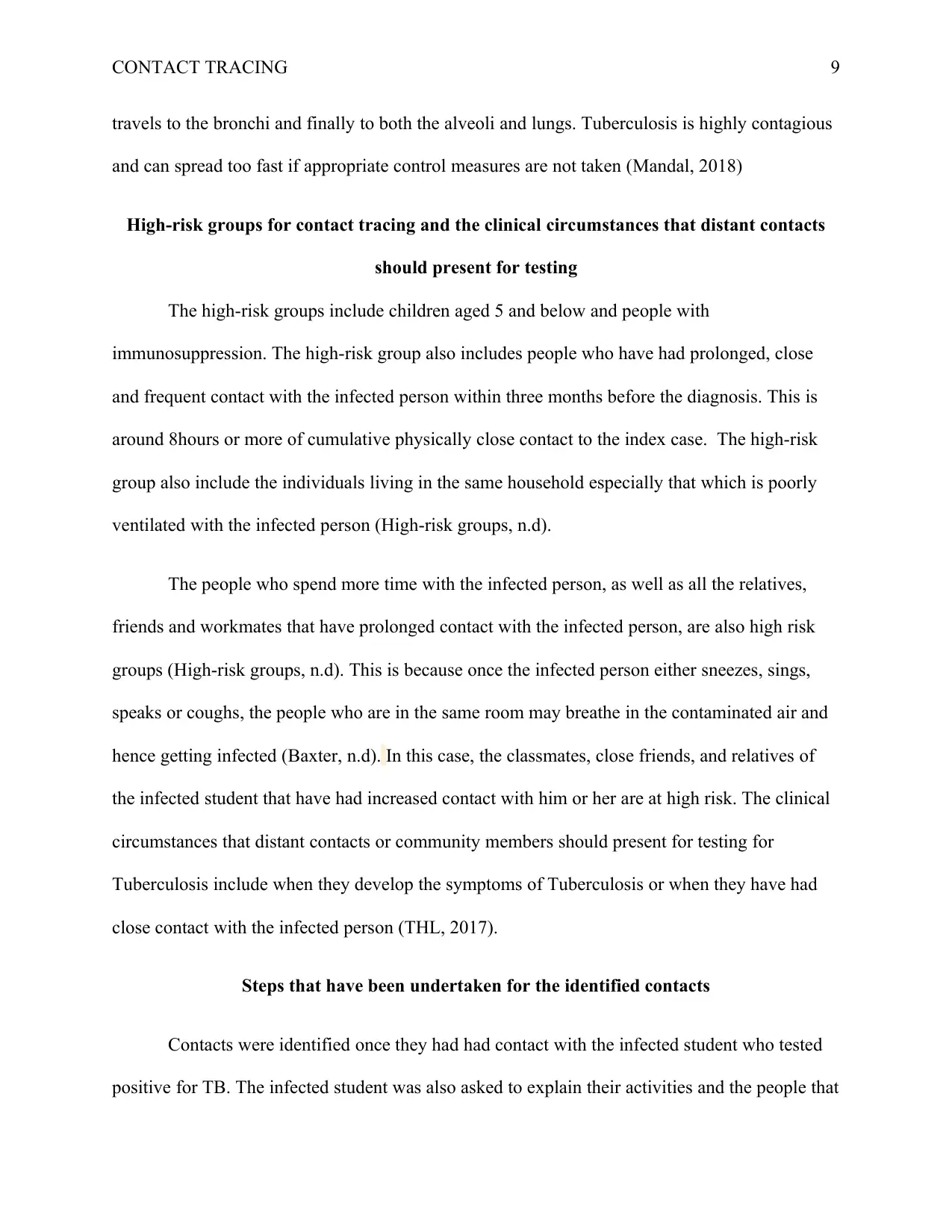
CONTACT TRACING 9
travels to the bronchi and finally to both the alveoli and lungs. Tuberculosis is highly contagious
and can spread too fast if appropriate control measures are not taken (Mandal, 2018)
High-risk groups for contact tracing and the clinical circumstances that distant contacts
should present for testing
The high-risk groups include children aged 5 and below and people with
immunosuppression. The high-risk group also includes people who have had prolonged, close
and frequent contact with the infected person within three months before the diagnosis. This is
around 8hours or more of cumulative physically close contact to the index case. The high-risk
group also include the individuals living in the same household especially that which is poorly
ventilated with the infected person (High-risk groups, n.d).
The people who spend more time with the infected person, as well as all the relatives,
friends and workmates that have prolonged contact with the infected person, are also high risk
groups (High-risk groups, n.d). This is because once the infected person either sneezes, sings,
speaks or coughs, the people who are in the same room may breathe in the contaminated air and
hence getting infected (Baxter, n.d). In this case, the classmates, close friends, and relatives of
the infected student that have had increased contact with him or her are at high risk. The clinical
circumstances that distant contacts or community members should present for testing for
Tuberculosis include when they develop the symptoms of Tuberculosis or when they have had
close contact with the infected person (THL, 2017).
Steps that have been undertaken for the identified contacts
Contacts were identified once they had had contact with the infected student who tested
positive for TB. The infected student was also asked to explain their activities and the people that
travels to the bronchi and finally to both the alveoli and lungs. Tuberculosis is highly contagious
and can spread too fast if appropriate control measures are not taken (Mandal, 2018)
High-risk groups for contact tracing and the clinical circumstances that distant contacts
should present for testing
The high-risk groups include children aged 5 and below and people with
immunosuppression. The high-risk group also includes people who have had prolonged, close
and frequent contact with the infected person within three months before the diagnosis. This is
around 8hours or more of cumulative physically close contact to the index case. The high-risk
group also include the individuals living in the same household especially that which is poorly
ventilated with the infected person (High-risk groups, n.d).
The people who spend more time with the infected person, as well as all the relatives,
friends and workmates that have prolonged contact with the infected person, are also high risk
groups (High-risk groups, n.d). This is because once the infected person either sneezes, sings,
speaks or coughs, the people who are in the same room may breathe in the contaminated air and
hence getting infected (Baxter, n.d). In this case, the classmates, close friends, and relatives of
the infected student that have had increased contact with him or her are at high risk. The clinical
circumstances that distant contacts or community members should present for testing for
Tuberculosis include when they develop the symptoms of Tuberculosis or when they have had
close contact with the infected person (THL, 2017).
Steps that have been undertaken for the identified contacts
Contacts were identified once they had had contact with the infected student who tested
positive for TB. The infected student was also asked to explain their activities and the people that
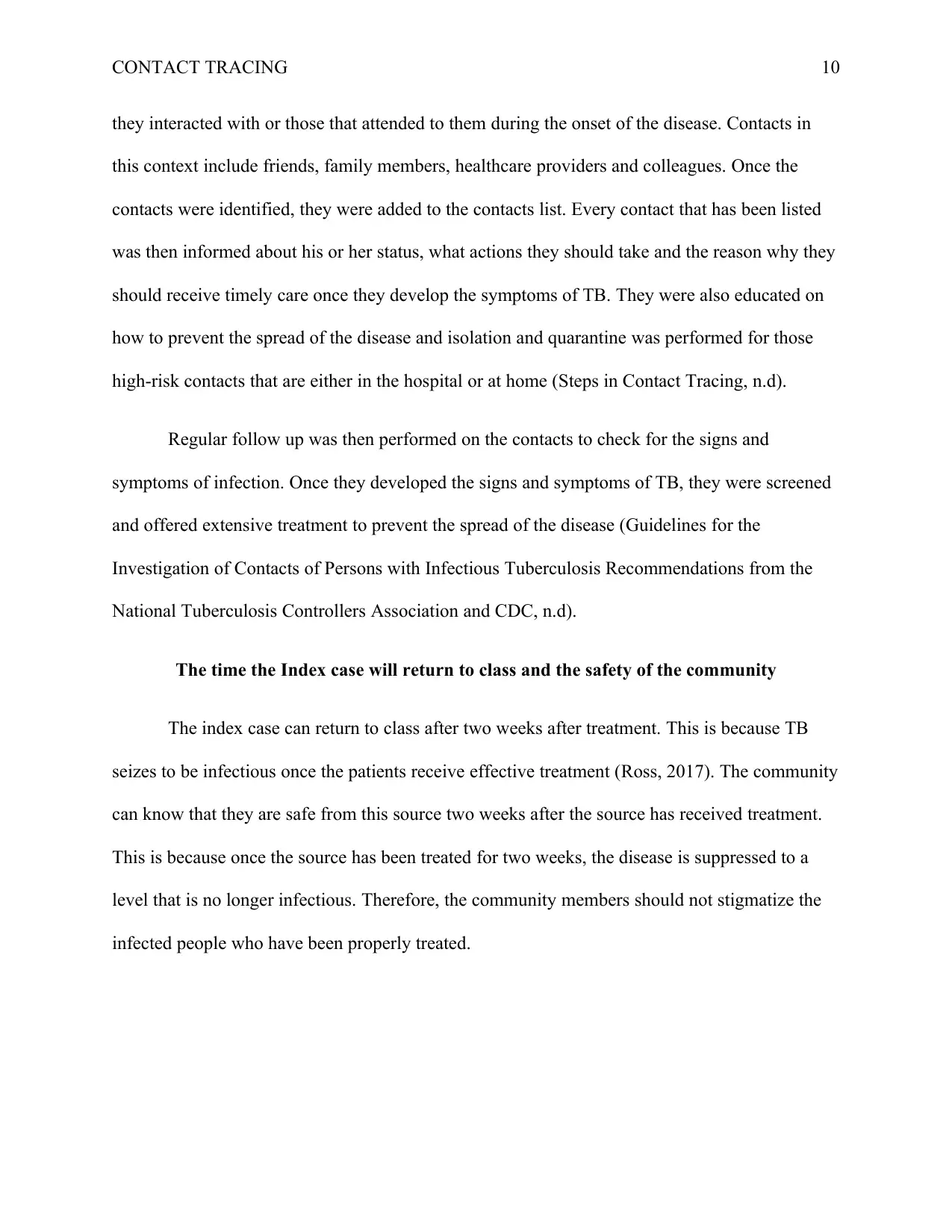
CONTACT TRACING 10
they interacted with or those that attended to them during the onset of the disease. Contacts in
this context include friends, family members, healthcare providers and colleagues. Once the
contacts were identified, they were added to the contacts list. Every contact that has been listed
was then informed about his or her status, what actions they should take and the reason why they
should receive timely care once they develop the symptoms of TB. They were also educated on
how to prevent the spread of the disease and isolation and quarantine was performed for those
high-risk contacts that are either in the hospital or at home (Steps in Contact Tracing, n.d).
Regular follow up was then performed on the contacts to check for the signs and
symptoms of infection. Once they developed the signs and symptoms of TB, they were screened
and offered extensive treatment to prevent the spread of the disease (Guidelines for the
Investigation of Contacts of Persons with Infectious Tuberculosis Recommendations from the
National Tuberculosis Controllers Association and CDC, n.d).
The time the Index case will return to class and the safety of the community
The index case can return to class after two weeks after treatment. This is because TB
seizes to be infectious once the patients receive effective treatment (Ross, 2017). The community
can know that they are safe from this source two weeks after the source has received treatment.
This is because once the source has been treated for two weeks, the disease is suppressed to a
level that is no longer infectious. Therefore, the community members should not stigmatize the
infected people who have been properly treated.
they interacted with or those that attended to them during the onset of the disease. Contacts in
this context include friends, family members, healthcare providers and colleagues. Once the
contacts were identified, they were added to the contacts list. Every contact that has been listed
was then informed about his or her status, what actions they should take and the reason why they
should receive timely care once they develop the symptoms of TB. They were also educated on
how to prevent the spread of the disease and isolation and quarantine was performed for those
high-risk contacts that are either in the hospital or at home (Steps in Contact Tracing, n.d).
Regular follow up was then performed on the contacts to check for the signs and
symptoms of infection. Once they developed the signs and symptoms of TB, they were screened
and offered extensive treatment to prevent the spread of the disease (Guidelines for the
Investigation of Contacts of Persons with Infectious Tuberculosis Recommendations from the
National Tuberculosis Controllers Association and CDC, n.d).
The time the Index case will return to class and the safety of the community
The index case can return to class after two weeks after treatment. This is because TB
seizes to be infectious once the patients receive effective treatment (Ross, 2017). The community
can know that they are safe from this source two weeks after the source has received treatment.
This is because once the source has been treated for two weeks, the disease is suppressed to a
level that is no longer infectious. Therefore, the community members should not stigmatize the
infected people who have been properly treated.
Secure Best Marks with AI Grader
Need help grading? Try our AI Grader for instant feedback on your assignments.
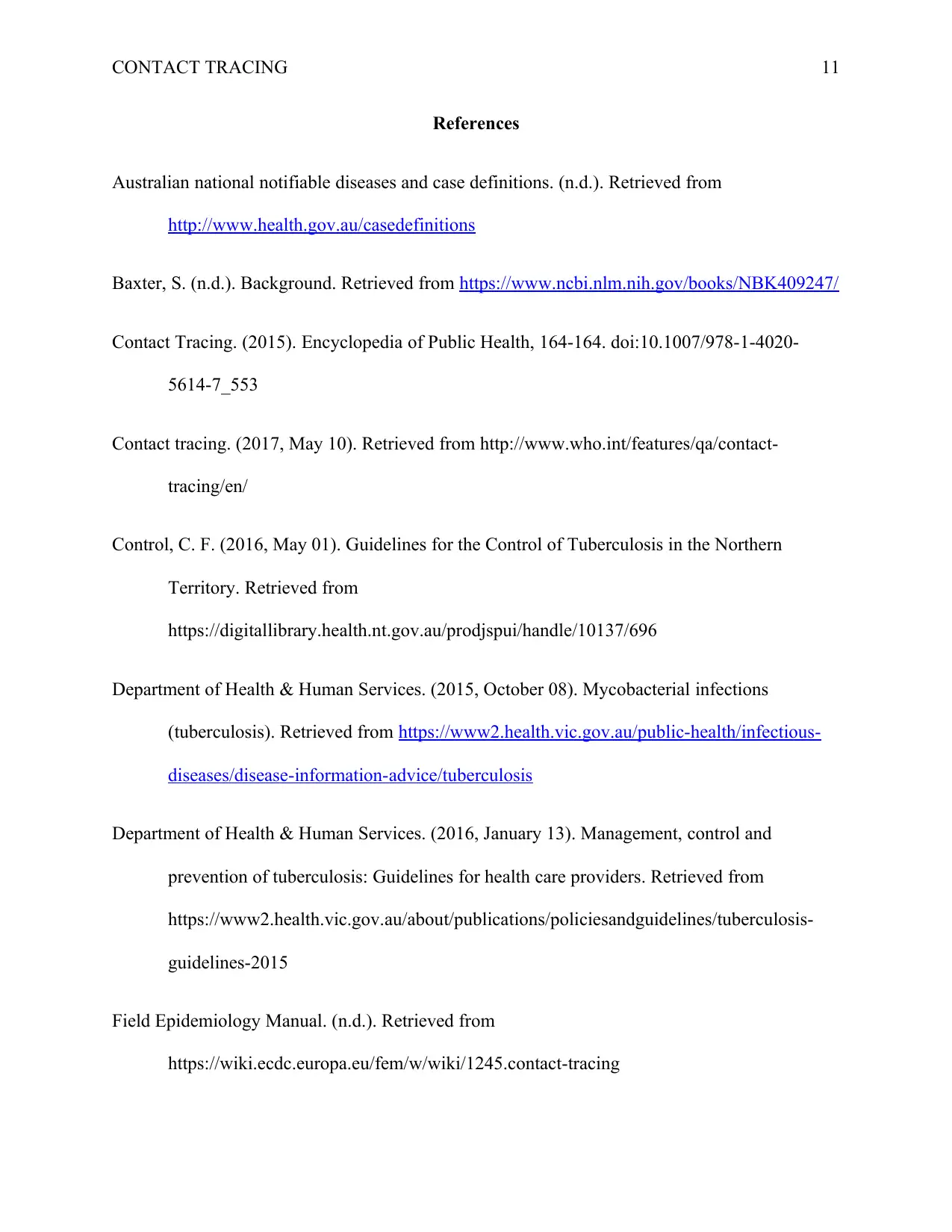
CONTACT TRACING 11
References
Australian national notifiable diseases and case definitions. (n.d.). Retrieved from
http://www.health.gov.au/casedefinitions
Baxter, S. (n.d.). Background. Retrieved from https://www.ncbi.nlm.nih.gov/books/NBK409247/
Contact Tracing. (2015). Encyclopedia of Public Health, 164-164. doi:10.1007/978-1-4020-
5614-7_553
Contact tracing. (2017, May 10). Retrieved from http://www.who.int/features/qa/contact-
tracing/en/
Control, C. F. (2016, May 01). Guidelines for the Control of Tuberculosis in the Northern
Territory. Retrieved from
https://digitallibrary.health.nt.gov.au/prodjspui/handle/10137/696
Department of Health & Human Services. (2015, October 08). Mycobacterial infections
(tuberculosis). Retrieved from https://www2.health.vic.gov.au/public-health/infectious-
diseases/disease-information-advice/tuberculosis
Department of Health & Human Services. (2016, January 13). Management, control and
prevention of tuberculosis: Guidelines for health care providers. Retrieved from
https://www2.health.vic.gov.au/about/publications/policiesandguidelines/tuberculosis-
guidelines-2015
Field Epidemiology Manual. (n.d.). Retrieved from
https://wiki.ecdc.europa.eu/fem/w/wiki/1245.contact-tracing
References
Australian national notifiable diseases and case definitions. (n.d.). Retrieved from
http://www.health.gov.au/casedefinitions
Baxter, S. (n.d.). Background. Retrieved from https://www.ncbi.nlm.nih.gov/books/NBK409247/
Contact Tracing. (2015). Encyclopedia of Public Health, 164-164. doi:10.1007/978-1-4020-
5614-7_553
Contact tracing. (2017, May 10). Retrieved from http://www.who.int/features/qa/contact-
tracing/en/
Control, C. F. (2016, May 01). Guidelines for the Control of Tuberculosis in the Northern
Territory. Retrieved from
https://digitallibrary.health.nt.gov.au/prodjspui/handle/10137/696
Department of Health & Human Services. (2015, October 08). Mycobacterial infections
(tuberculosis). Retrieved from https://www2.health.vic.gov.au/public-health/infectious-
diseases/disease-information-advice/tuberculosis
Department of Health & Human Services. (2016, January 13). Management, control and
prevention of tuberculosis: Guidelines for health care providers. Retrieved from
https://www2.health.vic.gov.au/about/publications/policiesandguidelines/tuberculosis-
guidelines-2015
Field Epidemiology Manual. (n.d.). Retrieved from
https://wiki.ecdc.europa.eu/fem/w/wiki/1245.contact-tracing
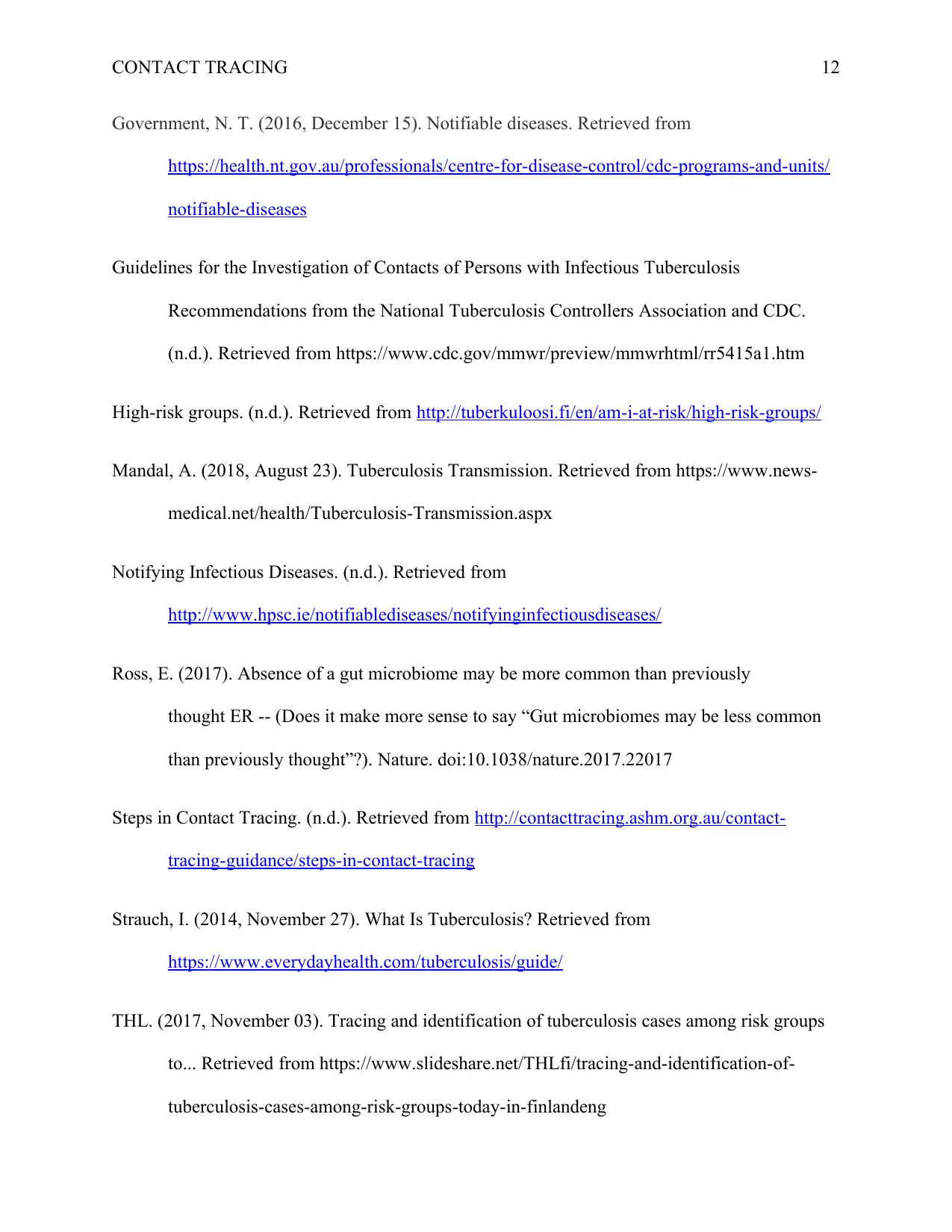
CONTACT TRACING 12
Government, N. T. (2016, December 15). Notifiable diseases. Retrieved from
https://health.nt.gov.au/professionals/centre-for-disease-control/cdc-programs-and-units/
notifiable-diseases
Guidelines for the Investigation of Contacts of Persons with Infectious Tuberculosis
Recommendations from the National Tuberculosis Controllers Association and CDC.
(n.d.). Retrieved from https://www.cdc.gov/mmwr/preview/mmwrhtml/rr5415a1.htm
High-risk groups. (n.d.). Retrieved from http://tuberkuloosi.fi/en/am-i-at-risk/high-risk-groups/
Mandal, A. (2018, August 23). Tuberculosis Transmission. Retrieved from https://www.news-
medical.net/health/Tuberculosis-Transmission.aspx
Notifying Infectious Diseases. (n.d.). Retrieved from
http://www.hpsc.ie/notifiablediseases/notifyinginfectiousdiseases/
Ross, E. (2017). Absence of a gut microbiome may be more common than previously
thought ER -- (Does it make more sense to say “Gut microbiomes may be less common
than previously thought”?). Nature. doi:10.1038/nature.2017.22017
Steps in Contact Tracing. (n.d.). Retrieved from http://contacttracing.ashm.org.au/contact-
tracing-guidance/steps-in-contact-tracing
Strauch, I. (2014, November 27). What Is Tuberculosis? Retrieved from
https://www.everydayhealth.com/tuberculosis/guide/
THL. (2017, November 03). Tracing and identification of tuberculosis cases among risk groups
to... Retrieved from https://www.slideshare.net/THLfi/tracing-and-identification-of-
tuberculosis-cases-among-risk-groups-today-in-finlandeng
Government, N. T. (2016, December 15). Notifiable diseases. Retrieved from
https://health.nt.gov.au/professionals/centre-for-disease-control/cdc-programs-and-units/
notifiable-diseases
Guidelines for the Investigation of Contacts of Persons with Infectious Tuberculosis
Recommendations from the National Tuberculosis Controllers Association and CDC.
(n.d.). Retrieved from https://www.cdc.gov/mmwr/preview/mmwrhtml/rr5415a1.htm
High-risk groups. (n.d.). Retrieved from http://tuberkuloosi.fi/en/am-i-at-risk/high-risk-groups/
Mandal, A. (2018, August 23). Tuberculosis Transmission. Retrieved from https://www.news-
medical.net/health/Tuberculosis-Transmission.aspx
Notifying Infectious Diseases. (n.d.). Retrieved from
http://www.hpsc.ie/notifiablediseases/notifyinginfectiousdiseases/
Ross, E. (2017). Absence of a gut microbiome may be more common than previously
thought ER -- (Does it make more sense to say “Gut microbiomes may be less common
than previously thought”?). Nature. doi:10.1038/nature.2017.22017
Steps in Contact Tracing. (n.d.). Retrieved from http://contacttracing.ashm.org.au/contact-
tracing-guidance/steps-in-contact-tracing
Strauch, I. (2014, November 27). What Is Tuberculosis? Retrieved from
https://www.everydayhealth.com/tuberculosis/guide/
THL. (2017, November 03). Tracing and identification of tuberculosis cases among risk groups
to... Retrieved from https://www.slideshare.net/THLfi/tracing-and-identification-of-
tuberculosis-cases-among-risk-groups-today-in-finlandeng
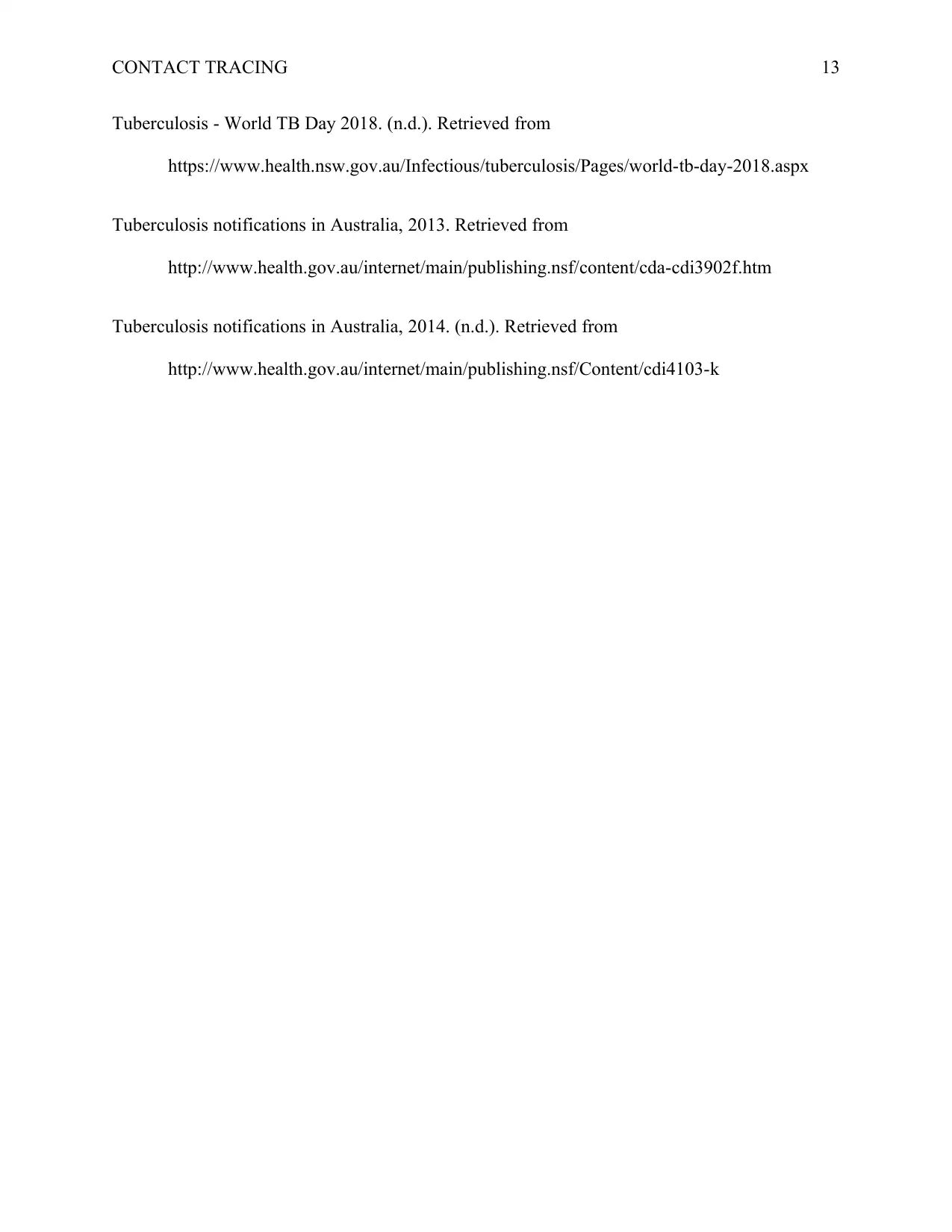
CONTACT TRACING 13
Tuberculosis - World TB Day 2018. (n.d.). Retrieved from
https://www.health.nsw.gov.au/Infectious/tuberculosis/Pages/world-tb-day-2018.aspx
Tuberculosis notifications in Australia, 2013. Retrieved from
http://www.health.gov.au/internet/main/publishing.nsf/content/cda-cdi3902f.htm
Tuberculosis notifications in Australia, 2014. (n.d.). Retrieved from
http://www.health.gov.au/internet/main/publishing.nsf/Content/cdi4103-k
Tuberculosis - World TB Day 2018. (n.d.). Retrieved from
https://www.health.nsw.gov.au/Infectious/tuberculosis/Pages/world-tb-day-2018.aspx
Tuberculosis notifications in Australia, 2013. Retrieved from
http://www.health.gov.au/internet/main/publishing.nsf/content/cda-cdi3902f.htm
Tuberculosis notifications in Australia, 2014. (n.d.). Retrieved from
http://www.health.gov.au/internet/main/publishing.nsf/Content/cdi4103-k
1 out of 13
Related Documents
Your All-in-One AI-Powered Toolkit for Academic Success.
+13062052269
info@desklib.com
Available 24*7 on WhatsApp / Email
![[object Object]](/_next/static/media/star-bottom.7253800d.svg)
Unlock your academic potential
© 2024 | Zucol Services PVT LTD | All rights reserved.





